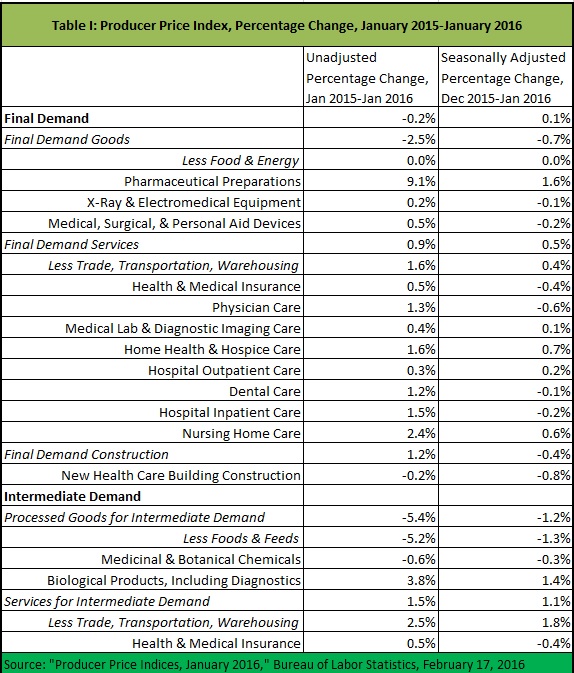PPI: Physician Prices Pull Back
 December’s surprising jump in physician prices looks to have been idiosyncratic. January’s Producer Price Index for physician services declined 0.6 percent, versus a 0.5 percent rise in prices of final demand services. Prices for home health and hospice care increased 0.7 percent on the month. However, other prices for final demand health services were in line with other services inflation.
December’s surprising jump in physician prices looks to have been idiosyncratic. January’s Producer Price Index for physician services declined 0.6 percent, versus a 0.5 percent rise in prices of final demand services. Prices for home health and hospice care increased 0.7 percent on the month. However, other prices for final demand health services were in line with other services inflation.
For final demand goods, prices for pharmaceutical preparations increased 1.6 percent, versus zero change for final demand goods less food and energy. (When the next Consumer Price Index is released on February 19, we will see whether the divergence between pharmaceutical prices in the PPI and CPI continues.) With respect to intermediate demand goods, prices of biologics, including diagnostics, increased 1.1 percent, versus a 1.3 percent decline in prices of processed goods, less foods and feeds.
It does not look like complaints about high and increasing prices for pharmaceuticals and biologics will be going away soon. (See Table I below the fold.)



It doesn’t surprise me that healthcare cost are up in the month of December because all of these bozos on employer-based health insurance with a FSA have to spend their money by 12/31 or lose it.
People still say that they think tax-free HSAs are tricky because they have lost money before at the end of the year. That is how confused the world is. People always think the HSA is an old boring FSA from some uninformed employer.
That’s why some people buy 4 pairs of Rx sunglasses on 12/28 at the mall. Suckers for FSA advertising.
This is (and will continue to be) especially be true of biologics and other so-called specialty drugs. Although only 1% of drugs prescribed, nearly one-third of drug spending in on specialty drugs. On the other hand, the FDA has sped up the approval of generic drug applications. Currently, 88% of drugs are dispensed in generic form. Although nearly 9-in-10 drugs are generic, total generic drug spending is significantly less than the amount spent on specialty drugs.